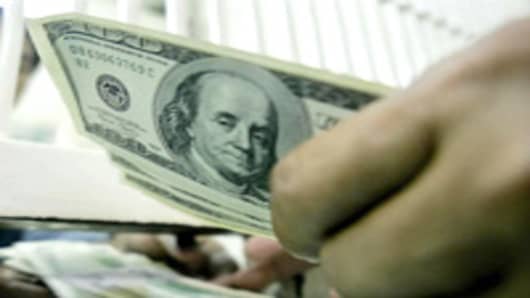The dollar fell against the yen and gave up much of its gains versus the euro Monday after rating agency Standard & Poor's downgraded U.S. financial sector firms.
The dollar extended losses to an intraday trough of 104.03 yen, according to Reuters data, and was last at 104.14 yen, down 1.3 percent on the day. The euro traded up 0.1 percent at 1.5566, rebounding from earlier losses that pushed it as low as $1.5488 in overnight trade.
"The dollar dropped on the negative ratings actions by S&P on various U.S. financial sector firms. This is pretty big news and should provide further dollar downside potential," said a trader at Forex.com in Bedminster, New Jersey.
The yen rose broadly Monday, posting its largest daily gain against the U.S. dollar in nine weeks, while sterling fell after a warning by a British lender on the state of the UK mortgage market rekindled worries about the health of the global financial sector.
Bradford & Bingley said funding costs remain high and the risk of customers defaulting on loans is rising faster than expected and slashed the price of its emergency rights issue to secure a private equity lifeline, hitting European bank shares. The news soured investors' appetite for risk, prompting them to buy the yen .
The yen tends to get bid in times of heightened risk aversion as investors unwind trades financed by borrowing the Japanese currency at low interest rates.
"We've seen the yen gain, and this is a continuation of the trend we saw overnight in terms of the renewed level of risk aversion that was sparked by the disappointing news out of the UK mortgage market," said Joe Manimbo, currency strategist at Ruesch International in Washington.
In the bleakest outlook yet from a British lender, B&B also said it had tumbled to a loss for the first four months of the year.
The news came as official data showed approvals for new home loans in Britain hit a record low in April.
U.S. stocks also posted steep losses, weighed down by the UK news and turmoil at a big U.S. bank, along with data showing U.S. inflation pressures surged to their highest level since April 2004 as indicated in the Institute for Supply Management report.
"We saw a surge in the prices paid component of the ISM. That has heightened inflation jitters out of the U.S. and that has elevated risk aversion," Manimbo added.
On the ISM report, Dustin Reid, senior currency strategist at ABN Amro in Chicago, said the weaker dollar is having a "double-edged effect—U.S. production is holding up, but at the expense of prices."
In midday New York trading, the dollar fell 1.1 percent against the yen to 104.31, on pace to post its largest daily fall since March 26. The euro slid 1.2 percent to 162.20 yen, its sharpest daily fall in about 10 weeks at current prices. European stocks also faltered, led by losses in bank shares.
Sterling fell 0.8 percent to $1.9653, hitting one-week lows of $1.9597 after the poor UK mortgage news and PMI data showed a stagnant manufacturing sector. The euro also posted sharp gains versus sterling, rising 0.8 percent to 79.03 pence.
The euro eased as euro-zone manufacturing activity hit its lowest level in almost three years. The euro zone's Purchasing Managers' Index of manufacturing in May slipped to 50.6, its lowest reading since August 2005.
The single euro zone currency traded little changed versus the dollar at $1.5548, having struck a two-week low of $1.5460 on Friday.
Despite signs of economic weakness, the European Central Bank has stuck to its position of ensuring inflation does not get out of hand, which suggests it will be wary of cutting interest rates from the current 4 percent to help spur growth.
That was highlighted again Monday as ECB President Jean-Claude Trichet said the bank will continue to focus on its primary aim of price stability. Trichet's comments kept the euro supported despite a higher-than expected ISM index for May.
The dollar, meanwhile, continued to garner broad support, having rebounded amid prospects of eventual U.S. monetary tightening from the current 2 percent to deal with inflation.
The euro has retreated some 3 percent from a record high of $1.6018 hit in April, according to Reuters data, with interest rate speculation helping the U.S. currency score back-to-back monthly gains against the single currency in April and May for the first time since early 2007.


